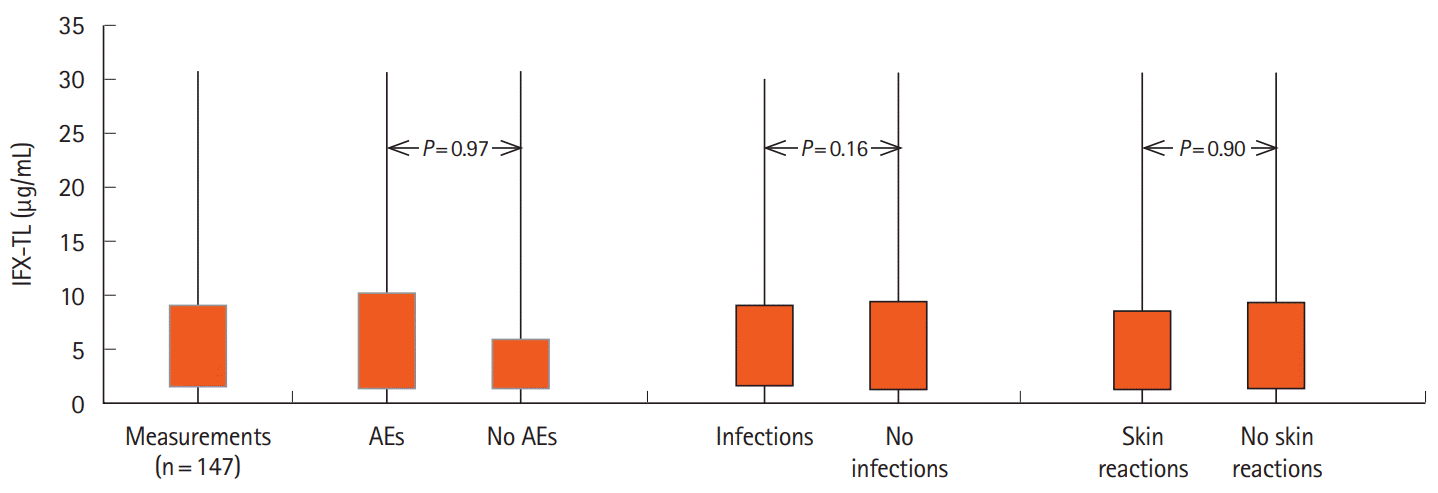1. Schnitzler F, Fidder H, Ferrante M, et al. Mucosal healing predicts long-term outcome of maintenance therapy with infliximab in Crohn’s disease. Inflamm Bowel Dis. 2009; 15:1295–1301.
2. Colombel JF, Sandborn WJ, Rutgeerts P, et al. Comparison of two adalimumab treatment schedule strategies for moderate-to-severe Crohn’s disease: results from the CHARM trial. Am J Gastroenterol. 2009; 104:1170–1179.
3. Papamichael K, Lin S, Moore M, Papaioannou G, Sattler L, Cheifetz AS. Infliximab in inflammatory bowel disease. Ther Adv Chronic Dis. 2019; 10:2040622319838443.
4. van Hoeve K, Dreesen E, Hoffman I, et al. Higher infliximab trough levels are associated with better outcome in paediatric patients with inflammatory bowel disease. J Crohns Colitis. 2018; 12:1316–1325.
5. Hoentjen F, van Bodegraven AA. Safety of anti-tumor necrosis factor therapy in inflammatory bowel disease. World J Gastroenterol. 2009; 15:2067–2073.
6. Antoni C, Braun J. Side effects of anti-TNF therapy: current knowledge. Clin Exp Rheumatol. 2002; 20(6 Suppl 28):S152–S157.
7. Lichtenstein L, Ron Y, Kivity S, et al. Infliximab-related infusion reactions: systematic review. J Crohns Colitis. 2015; 9:806–815.
8. Kamperidis N, Middleton P, Tyrrell T, Stasinos I, Arebi N. Impact of therapeutic drug level monitoring on outcomes of patients with Crohn’s disease treated with infliximab: real world data from a retrospective single centre cohort study. Frontline Gastroenterol. 2019; 10:330–336.
9. Quezada SM, McLean LP, Cross RK. Adverse events in IBD therapy: the 2018 update. Expert Rev Gastroenterol Hepatol. 2018; 12:1183–1191.
10. Greener T, Kabakchiev B, Steinhart AH, Silverberg MS. Higher infliximab levels are not associated with an increase in adverse events in inflammatory bowel disease. Inflamm Bowel Dis. 2018; 24:1808–1814.
11. Guiotto C, Daperno M, Frigerio F, et al. Clinical relevance and inter-test reliability of anti-infliximab antibodies and infliximab trough levels in patients with inflammatory bowel disease. Dig Liver Dis. 2016; 48:138–143.
12. Huang V, Dhami N, Fedorak D, et al. A study investigating the association of dermatological and infusion reactions to infliximab and infliximab trough levels. Can J Gastroenterol Hepatol. 2015; 29:35–40.
13. Protic M, Münger C, Seibold F. SA1267 psoriasis induced by anti TNF treatment in patients with inflammatory bowel disease: a single center study. Gastroenterology. 2014; 146(5 Supple 1):S247–S248.
14. Cleynen I, Van Moerkercke W, Billiet T, et al. Anti‐TNF‐induced skin manifestations in IBD patients: role for increased drug exposure? Gastroenterology. 2015; 148(4 Suppl 1):S–108.
15. Drobne D, Kurent T, Golob S, et al. Success and safety of high infliximab trough levels in inflammatory bowel disease. Scand J Gastroenterol. 2018; 53:940–946.
16. Coutzac C, Chapuis J, Poullenot F, et al. Association between infliximab trough levels and the occurrence of paradoxical manifestations in patients with inflammatory bowel disease: a case-control study. J Crohns Colitis. 2015; 9:982–987.
17. Moore C, Corbett G, Moss AC. Systematic review and meta-analysis: serum infliximab levels during maintenance therapy and outcomes in inflammatory bowel disease. J Crohns Colitis. 2016; 10:619–625.
18. Orfanoudaki E, Gazouli M, Foteinogiannopoulou K, et al. Infliximab trough levels are decreasing over time in patients with inflammatory bowel disease on maintenance treatment with infliximab. Eur J Gastroenterol Hepatol. 2019; 31:187–191.
19. Vermeire S, Noman M, Van Assche G, Baert F, D’Haens G, Rutgeerts P. Effectiveness of concomitant immunosuppressive therapy in suppressing the formation of antibodies to infliximab in Crohn’s disease. Gut. 2007; 56:1226–1231.
20. Ben-Horin S, Waterman M, Kopylov U, et al. Addition of an immunomodulator to infliximab therapy eliminates antidrug antibodies in serum and restores clinical response of patients with inflammatory bowel disease. Clin Gastroenterol Hepatol. 2013; 11:444–447.





 PDF
PDF Citation
Citation Print
Print




 XML Download
XML Download